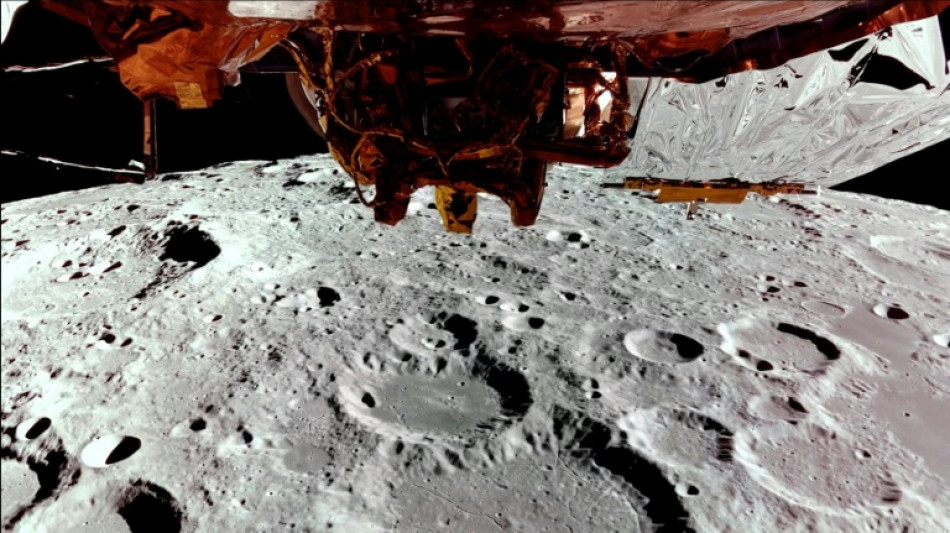
-
 Clashes erupt in Mexico City anti-crime protests, injuring 120
Clashes erupt in Mexico City anti-crime protests, injuring 120
-
India, without Gill, 10-2 at lunch chasing 124 to beat S.Africa

-
 Bavuma fifty makes India chase 124 in first Test
Bavuma fifty makes India chase 124 in first Test
-
Mitchell ton lifts New Zealand to 269-7 in first Windies ODI

-
 Ex-abbot of China's Shaolin Temple arrested for embezzlement
Ex-abbot of China's Shaolin Temple arrested for embezzlement
-
Doncic scores 41 to propel Lakers to NBA win over Bucks

-
 Colombia beats New Zealand 2-1 in friendly clash
Colombia beats New Zealand 2-1 in friendly clash
-
France's Aymoz wins Skate America men's gold as Tomono falters

-
 Gambling ads target Indonesian Meta users despite ban
Gambling ads target Indonesian Meta users despite ban
-
Joe Root: England great chases elusive century in Australia

-
 England's Archer in 'happy place', Wood 'full of energy' ahead of Ashes
England's Archer in 'happy place', Wood 'full of energy' ahead of Ashes
-
Luxury houses eye India, but barriers remain

-
 Budget coffee start-up leaves bitter taste in Berlin
Budget coffee start-up leaves bitter taste in Berlin
-
Reyna, Balogun on target for USA in 2-1 win over Paraguay

-
 Japa's Miura and Kihara capture Skate America pairs gold
Japa's Miura and Kihara capture Skate America pairs gold
-
Who can qualify for 2026 World Cup in final round of European qualifiers

-
 UK to cut protections for refugees under asylum 'overhaul'
UK to cut protections for refugees under asylum 'overhaul'
-
England's Tuchel plays down records before final World Cup qualifier

-
 Depoortere double helps France hold off spirited Fiji
Depoortere double helps France hold off spirited Fiji
-
Scotland face World Cup shootout against Denmark after Greece defeat

-
 Hansen hat-trick inspires Irish to record win over Australia
Hansen hat-trick inspires Irish to record win over Australia
-
Alcaraz secures ATP Finals showdown with 'favourite' Sinner

-
 UK to cut protections for refugees under asylum 'overhaul': govt
UK to cut protections for refugees under asylum 'overhaul': govt
-
Spain, Switzerland on World Cup brink as Belgium also made to wait

-
 Sweden's Grant leads by one at LPGA Annika tournament
Sweden's Grant leads by one at LPGA Annika tournament
-
Scotland cling to hopes of automatic World Cup qualification despite Greece defeat

-
 Alcaraz secures ATP Finals showdown with great rival Sinner
Alcaraz secures ATP Finals showdown with great rival Sinner
-
England captain Itoje savours 'special' New Zealand win

-
 Wales's Evans denies Japan historic win with last-gasp penalty
Wales's Evans denies Japan historic win with last-gasp penalty
-
Zelensky renews calls for more air defence after deadly strike on Kyiv

-
 NBA's struggling Pelicans sack coach Willie Green
NBA's struggling Pelicans sack coach Willie Green
-
Petain tribute comments raise 'revisionist' storm in France

-
 Spain on World Cup brink as Belgium also made to wait
Spain on World Cup brink as Belgium also made to wait
-
Spain virtually seal World Cup qualification in Georgia romp

-
 M23, DR Congo sign new peace roadmap in Doha
M23, DR Congo sign new peace roadmap in Doha
-
Estevao, Casemiro on target for Brazil in Senegal win

-
 Ford steers England to rare win over New Zealand
Ford steers England to rare win over New Zealand
-
Massive march in Brazil marks first big UN climate protest in years

-
 Spain rescues hundreds of exotic animals from unlicensed shelter
Spain rescues hundreds of exotic animals from unlicensed shelter
-
Huge fire sparked by explosions near Argentine capital 'contained'

-
 South Africa defy early red card to beat battling Italy
South Africa defy early red card to beat battling Italy
-
Sinner beats De Minaur to reach ATP Finals title match

-
 Zelensky vows overhaul of Ukraine's scandal-hit energy firms
Zelensky vows overhaul of Ukraine's scandal-hit energy firms
-
South Africa defy early red card to beat Italy

-
 Alex Marquez claims Valencia MotoGP sprint victory
Alex Marquez claims Valencia MotoGP sprint victory
-
McIlroy shares lead with Race to Dubai title in sight

-
 Climate protesters rally in Brazil at COP30 halfway mark
Climate protesters rally in Brazil at COP30 halfway mark
-
Spike Lee gifts pope Knicks jersey as pontiff meets film stars

-
 BBC caught in crossfire of polarised political and media landscape
BBC caught in crossfire of polarised political and media landscape
-
'Happy' Shiffrin dominates in Levi slalom for 102nd World Cup win


Two lunar landings in a week for NASA's private Moon fleet
More than fifty years passed between the last Apollo mission and the United States' return to the lunar surface, when the first-ever private lander touched down last February.
Now, starting Sunday, two more missions are set to follow within a single week, marking a bold push by NASA and its industry partners to make Moon landings a routine part of space exploration.
First up is Firefly Aerospace's Blue Ghost Mission 1, nicknamed "Ghost Riders in the Sky."
After launching in January on a 45-day journey, it is targeting touchdown near Mons Latreille, a volcanic feature in Mare Crisium on the Moon's northeastern near side, at 3:34 am US Eastern time (0834 GMT). Along the way, it has captured stunning footage of the Moon, coming as close as 60 miles (100 kilometers) above the surface.
The golden lander, about the size of a hippopotamus, carries ten instruments, including one to analyze lunar soil, another to test radiation-tolerant computing, and a GPS-based navigation system.
Designed to operate for a full lunar day (14 Earth days), Blue Ghost is expected to capture high-definition imagery of a total eclipse on March 14, when Earth blocks the Sun from the Moon's horizon.
On March 16, it will record a lunar sunset, offering insights into how dust levitates above the surface under solar influence -- creating the mysterious lunar horizon glow first documented by Apollo astronaut Eugene Cernan.
- Hopping drone -
Blue Ghost's arrival will be followed on March 6 by Intuitive Machines' IM-2 mission, featuring its lander, Athena.
Last year, Intuitive Machines made history as the first private company to achieve a soft landing on the Moon, though the moment was tempered by a mishap.
Coming down too fast, one of the lander's feet caught on the lunar surface, tipping it over and causing it to rest sideways -- limiting its ability to generate solar power and cutting the mission short.
This time, the company says it has made key improvements to the hexagonal-shaped lander, which has a taller, slimmer profile than Blue Ghost, and is around the height of an adult giraffe.
Athena launched on Wednesday aboard a SpaceX rocket, taking a more direct route toward Mons Mouton -- the southernmost lunar landing site ever attempted.
It carries an ambitious set of payloads, including a unique hopping drone designed to explore the Moon's underground passages carved by ancient lava flows, a drill capable of digging three feet beneath the surface in search of ice, and three rovers.
The largest, about the size of a beagle, will connect to the lander and hopper using a Nokia cellular network in a first-of-its-kind demonstration.
But "Grace," the hopping drone -- named after computing pioneer Grace Hopper -- could well steal the show if it succeeds in showing it can navigate the Moon's treacherous terrain in ways no rover can.
- NASA's private Moon fleet -
Landing on the Moon presents unique challenges due to the absence of an atmosphere, making parachutes ineffective. Instead, spacecraft must rely on precisely controlled thruster burns to slow their descent while navigating hazardous terrain.
Until Intuitive Machines' first successful mission, only five national space agencies had accomplished this feat: the Soviet Union, the United States, China, India and Japan, in that order.
Now, the United States is working to make private lunar missions routine through NASA's $2.6 billion Commercial Lunar Payload Services (CLPS) program, a public-private initiative designed to deliver hardware to the surface at a fraction of traditional mission costs.
These missions come at a pivotal moment for NASA, amid speculation that it may scale back or even cancel its Artemis lunar program in favor of prioritizing Mars exploration -- a key goal of both President Donald Trump and his close advisor, SpaceX founder Elon Musk.
D.AbuRida--SF-PST




